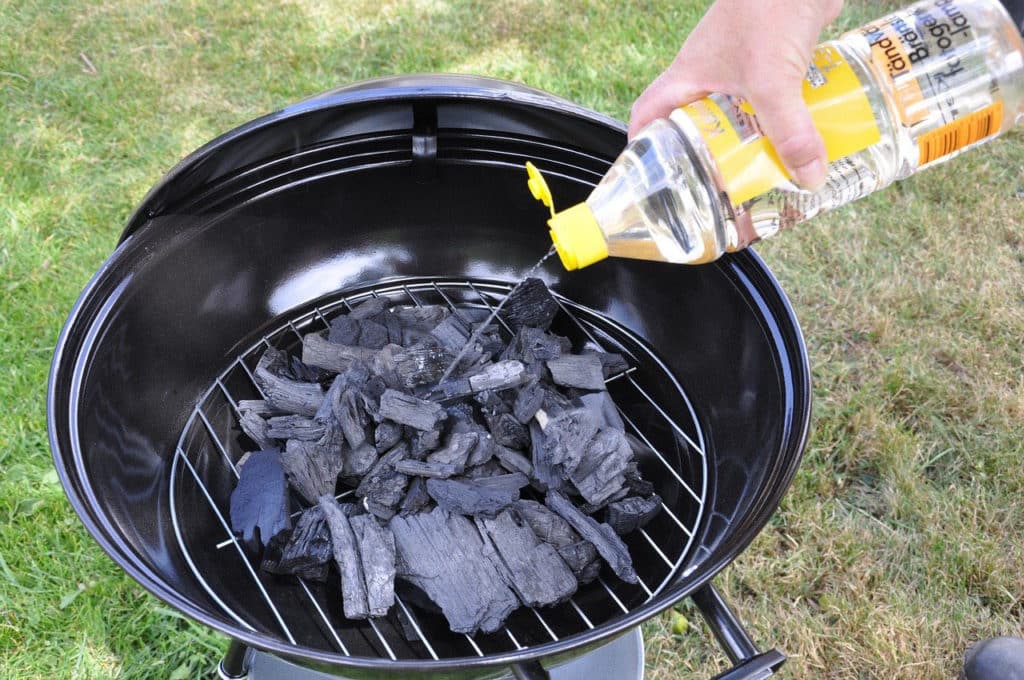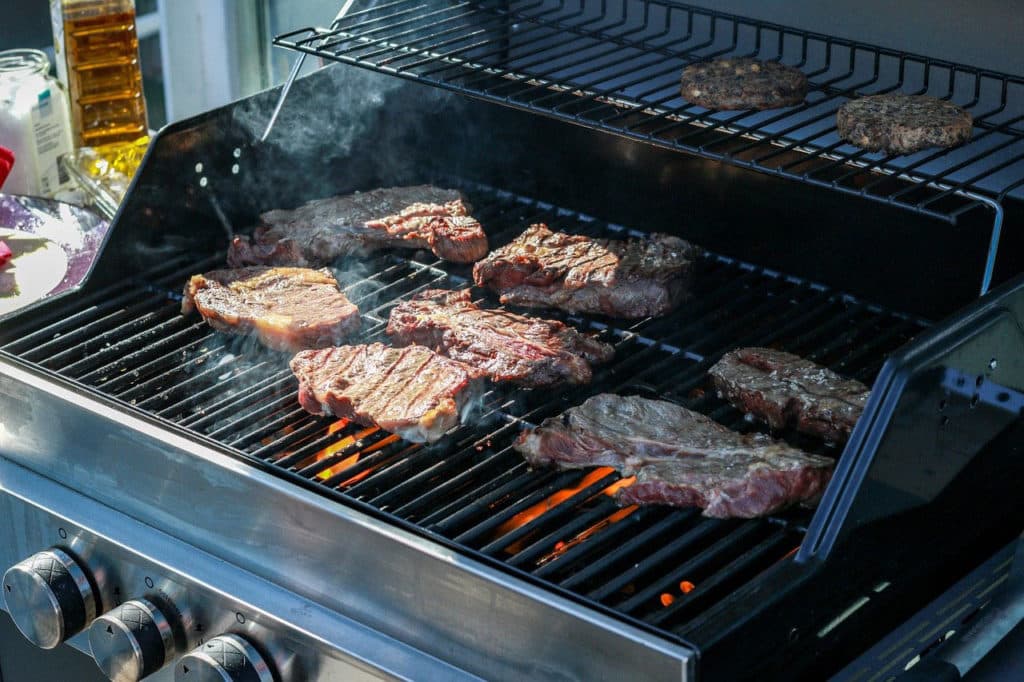As soon as the temperatures rise, it smells wonderfully of grilled food everywhere. The good weather lures many outside to grill suits. Enjoying nature, spending a nice evening with friends and acquaintances and organizing a great BBQ – this is one of the favorite activities of Germans.
Many terraces and balconies are equipped with awnings, which offer good protection in a rain shower.
But what about fire protection when barbecuing under the awning? Can the heat or flying sparks damage the awning? We explain all of this in this article.

What are the dangers of grilling under the awning?
Everyone of us knows it, the grilled food sizzles juicy on the grill and you don’t always pay attention to it. At least not in the early days, when meat or fish and vegetables are first placed on the grill. However, sparks can quickly fly into the surrounding area or flash fires can be caused by the fat dripping down. This can create a very dangerous situation. Especially when the jet of flame sets the grate suspension on fire and a fire quickly develops.
Another danger is the smoke. The awning can prevent the smoke outlet. This means that the smoke will not only get into the living quarters, but maybe also to the neighbors. This not only creates unpleasant rumours, but also the toxic gases can spread. Carbon monoxide, which is odorless and tasteless, gets into the interior. This in turn violates the Immission Control Act.
Especially with awning fabrics that have a special waterproof impregnation, the smoke cannot escape. The heat that is then generated can also cause the awning fabric to catch fire easily.
If you want to grill under an awning, you should definitely be aware that the awning can be damaged. Burn holes caused by flying sparks or spatters of fat that look unsightly can damage the awning. A layer of fat can definitely impair the functionality of the awning. But the service life is also reduced if you grill under the awning for a long time.
Proper lighting of the charcoal
Most accidents occur when lighting the charcoal. This is mostly due to the liquid fire accelerators, which are not infrequently used. For example, if denatured alcohol is spread on the charcoal, it will evaporate when the bottle is closed and put down. An aerosol cloud forms that can completely envelop the grill master. If the lighter is now ignited, a deflagration can occur and cause very serious burns. But not only the grill master is in danger, objects nearby can also catch fire if they are surrounded by this aerosol cloud.
Despite all the warnings, liquid fire accelerants are used again and again because people are not even aware of the danger. Because it is not the liquid itself that burns, but the vapors. Even going a little further away is of little use if the aerosol cloud has already enveloped the grill master. A deflagration, as occurs with fire accelerators, is always unpredictable!
Even more dangerous is the use of fire accelerants to rekindle a fire that has already died out in whole or in part. The charcoal usually glows a little and the deflagration can then be very violent. In addition, flashbacks can also occur. This means that the flame travels along the jet of liquid and can set the bottle or can on fire. This then bursts or flies away like a rocket. What can happen then, we do not have to go into detail here.

Proper lighting of the gas grill
Caution should always be exercised when using a gas grill. Depending on the manufacturer and design, the gas grill can be used with a gas bottle or a gas cartridge. These contain liquid gas, which should also not be underestimated. For safety reasons, the gas cylinder should be as small as possible.
The gas bottle itself may only be connected to the grill with a pressure reducer (50 mbar), otherwise too much gas would escape. Furthermore, the connections must not be porous or damaged. This should be checked carefully before each use. If possible, the connecting hose should be long enough for the gas bottle to be about one meter away from the grill. Firelighters are not necessary here – ignition source to the burner, turn on the gas and you’re ready to go.
Of course, deflagration can also occur here. As soon as the gas bottle is opened, gas flows out of the bottle. If the grill is not ignited immediately, a dangerous gas-air mixture can form and deflagration can occur. Therefore, caution is also required here when lighting.

How to safely grill under awnings?
Carelessness, carelessness, incorrect handling or the use of fire accelerants and dangerous lighters cause many thousands of barbecue accidents every year. Because not only the preparation to light the grill, but also the grilling itself requires a lot of attention that should not be underestimated.
Before the grill is put into operation, it must be ensured that there are enough vents for the smoke in all directions. In addition, the grill should be at least 3 to 5 meters away from trees, bushes, walls or railings. Unfortunately, this is not always possible on small balconies, which is why the gas or charcoal grill should be avoided. An electric grill is much better suited for small areas, as the risk of fire would be too great if charcoal or gas grills are used.
Of course, the charcoal grill, which gives the food on the grill a very special taste, is extremely popular. However, it has the disadvantage that it causes a lot of heat around the grill and the smoke should not be underestimated. With a gas grill, on the other hand, the temperature can be adjusted using a controller. The smoke development is also significantly lower compared to the charcoal grill. In addition, lava stones prevent the fat from dripping into the fire. In this way, no flare-ups can occur.
Furthermore, whether it is a charcoal or gas grill, always pay attention to safety. On the one hand, the quality of the grill plays a major role here. On the other hand, the position of the grill. Furthermore, no fire accelerants should be used in order to avoid deflagration or flash fires. In addition, every grill master should have emergency resources such as water, sand or a fire extinguisher in the immediate vicinity so that he can intervene immediately.
If you follow these little tips, you will usually be able to grill under the awning without any problems. Of course, an electric grill is particularly suitable here. There is no smoke, no open flame and therefore no flying sparks. In addition, an electric grill can also be used in the house or in the garden shed and can therefore be used much more flexibly than charcoal or gas grills. The disadvantage here is that the grilled food does not taste so wonderfully like smoked. But there are a few tips and tricks here too. If you spice up your meat, fish or vegetables with appropriate marinades beforehand, you will hardly taste a difference.
Follow the manufacturer's instructions - the awning fabric is crucial
Of course you will now say that barbecuing under the awning doesn’t actually take place at all, because the awning is not always extended when the weather is nice. This is of course correct. But if a barbecue party is planned and rain is forecast, the awning often serves as rain protection. Depending on which awning fabric your awning has, it is not always designed for it.
Basically, all awning fabrics are not very flammable. However, since temperatures of up to 800°C can develop during grilling, even polyester or polyacrylic is no longer safe from the flames. For this you need to know that 800°C can be reached in the flame. However, the grill grate can also reach temperatures of up to 500°C. Not to mention the sparks that fly. Even if the awning fabric is flame retardant, burn holes can still occur. Furthermore, many grill masters forget that when it rains, wind or storms also arise, which can significantly increase the number of sparks.
Fireproof and weatherproof fabrics
Fabrics that are weatherproof are specifically designed to be waterproof as well. A disadvantage of these substances, however, is that they have a very high density. This means that the heat as well as the smoke cannot escape. They collect under the awning fabric when there is no wind.
You will also find fabrics that are flame retardant. These substances are marked according to DIN 4102 B1. Flame retardant means that the fabrics are impregnated. But be careful. Environmental influences or frequent cleaning of the awning impair this property. If your awning is several years old, the impregnation is no longer necessary and the fabric is no longer flame retardant. Unless they have sun protection that says “permanently flame retardant”. This fabric has been structurally engineered to be durable and flame retardant without restriction. Frequent cleaning or environmental influences cannot harm the cloth.
Twilight fabric
Twilight fabric is free of PC but has a textile character made from polyester fibers. These are also aluminized or coated with a silver paste. Thus, these fabrics absorb heat, are flame retardant and fireproof. They are also dirt-repellent and therefore perfect for grilling under the awning. But here, too, special caution is always required!
fiberglass fabric
Soltis92 is an awning fabric made from glass fiber fabric. This is often used in public buildings because fire protection is excellent here. The fabric is flame retardant, waterproof and dirt-repellent. In addition, Soltis92 is also heat-absorbing.
It basically doesn’t matter which awning fabric you use. For fire safety reasons, you should not grill under an awning. The danger is too great and even if nothing happens, the awning can be damaged by flying sparks. Burn holes or grease stains are also not nice to look at and anyone who has spent a small fortune on their awning will bitterly regret barbecuing under the awning! Therefore, always make sure that you have enough distance to the extended awning to increase the service life of your sun protection.
